Contact Details: Scotch Macaskill, Dirt Road Traders, Currys Post Road, Howick, KwaZulu-Natal, South Africa. Tel: +27 (0)82 578 2329. Privacy: Your privacy is guaranteed. See our Privacy Policy for more. This site accepts advertising and other forms of compensation - see Disclosure and Advertising for details. Site updated: 2022. Copyright © 2002 - 2022 Scotch Macaskill

| ||||||||||
|
||||||||||
|
SEE ALL
|
African Elephant ~ Loxodonta AfricanaBy Daniel James Devine
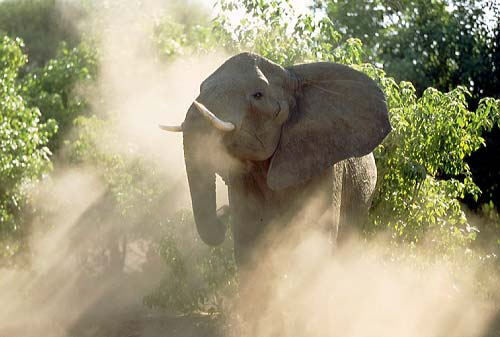
Out of the thicket thunders a massive beast, with tusks like spears and a trunk like a tree. Its ears flap wildly, like banners in an ancient war charge. Small amber eyes burn with undaunted resolution. It trumpets and begins to charge. Then it skids, stops, sniffs the air, and saunters down to a nearby mud hole. And we all say, fickle. 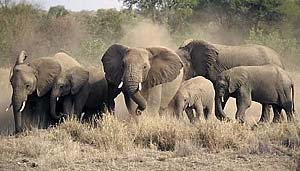
Elephant breeding herd Bigger is BetterIn the world of elephants, bigger is definitely better, even if it means just looking big. Male African elephants continue to grow throughout their 70 years, and can reach 7½ tons (more than two Hummers).Although they are known mostly for their size and shape, elephants possess a variety of amazing abilities that confound evolutionism, and lead complex social lives carried on through unique forms of communication, such as trunk touch and subsonic calls. A Closer LookFirst let's look at the elephant's body, starting at the bottom--the feet.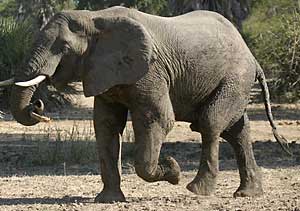
Elephant walking, side view The elephant's foot is a spongy pad with four or five toes and toenails. The pad acts like a cushion with each step, absorbing the impact and taking some strain off the leg. Like the pillars of a palace, an elephant's legs are positioned directly under it. In contrast, the legs of most other mammals, such as dogs or horses, are in an angular position. In addition elephant bones are semi-solid, lacking the normal marrow cavity in favor of a perforated bone tissue that provides optimum strength and still allows blood cell production. Both its legs and skeleton are suited to handle its massive weight, while not sacrificing too much in mobility. An elephant can walk forward and backward, amble at 25 mph, negotiate steep terrain, swim in deep water, and stand on its hind legs with the help of a tree. Notoriously thick-skinned (1 inch in some places), elephants are grey and rough to the touch, almost resembling stone. However, elephant skin is very sensitive, and they take pains to keep themselves cool and free of pests by wallowing in mud and flinging dust on themselves with their trunks.
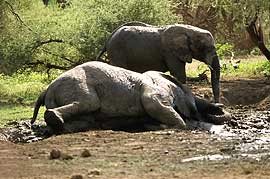
Elephant wallowing in mud 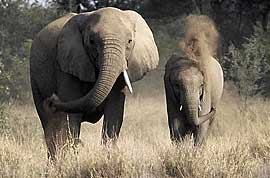
Elephant enjoying dust bath
Now, I know this doesn't sound like the cleanest way to go, but the mud is actually very affective at blocking UV radiation and heat, which elephants find much less comfortable than dirt. Ticks are especially bothersome, and elephants often have favorite scratching trees for noninvasive operations. Their skinny tails help keep off flies in the hindquarters, but when there is a serious itch, a sit and a rub on the nearest termite mound will do. A Word About the Hair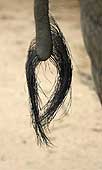
Elephant's Tail The lack or abundance of hair are just traits of natural selection, the end products of a common elephant ancestor. Other such traits are ears (larger in African elephants than in Asians), hind toes (Asians usually have four, Africans five), and teeth (African elephants sport less narrow teeth than their cousins, thus they are called Loxodonta -- "Lozenge-tooth"). The HeadSince an elephant head is so large, weighing hundreds of pounds, it is supported with extra muscles along the neck, and the skull has, like bird bones, many tiny air pockets to keep it light.Large ears not only boast a remarkable sense of hearing--more on that in a moment--but function as air conditioners, cooling the blood of a hot elephant by up to 15 degrees F as it flaps its ears. Tusks are deeply embedded in the skull and continue to grow throughout an adult's 60+ year life, although not all Asian elephants have tusks. They are used for friendly sparring, digging, foraging, scraping or pushing trees, as protection for the trunk, and occasionally for fighting. They're also a nice trunk rest, and, well, what do you do when you have an itch inside your nose? And the Amazing Trunk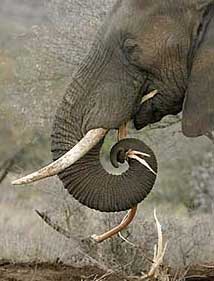
Elephant stripping bark At once both gentle and strong, a trunk is capable of killing a lion--or caressing a frightened elephant calf. It can pick leaves, pull bark off trees, and pick up objects as small as a coin. It can suck up a gallon of water to squirt into a mouth or on a hot back (Elephants do not drink through their trunk, but use it to draw the liquid). With their trunks elephants throw dust in the air, rub their eyes, greet one another, sound calls, test uncertain ground, smell danger--or a potential mate--and snorkel. African elephants have two lobes on the tips of their trunks (Asians have only one) that act like fingers. Since elephants spend most of their time eating and drinking, those fingers get a steady workout, grasping seeds, roots, fruit, flowers, leaves, branches, bark, grass, and even thorns to pacify an incurable appetite. Elephants can consume as much 300 pounds of forage a day, and up to 50 gallons of water. They drink whenever they can since they may have to go for a couple days or more without water during dry spells or while traveling. Elephants are fast walkers and some herds have been observed to cover 120 miles in one day. However, 15 miles is a closer average for an elephant. More than most of us walk, anyway. Social StructureA typical elephant family is comprised of a group of related females (maybe 2, maybe 40) and their young, including males younger than about 14. Different families sometimes meet and feed in the same area. The family is led by the oldest female, the "matriarch", and the others follow her lead in every circumstance. She decides when to stop, and when to move on, and where to go.
Elephant herd heading towards river for a drink Males are less communal, traveling sometimes among other males and at other times from family to family in search of mates. About once a year males enter a state of sexual excitement called musth, and they may fight one another for rights to a female. Elephant bulls in musth are famously uncontrollable, and take on violent, insane characteristics--even attacking their caretakers in captivity--and during this time glands on their cheeks, called the temporal glands, swell and emit a sticky liquid which can often be seen running down their faces. While in musth they send out low-frequency calls to other females, and if one responds in the distance they will follow her. A female who is "in heat," called estrus (and whose temporal glands will also be secreting), may not allow a male to mount her if she discovers he is young and small. Females prefer older males, and since older males ward off the younger, less experienced ones, it usually takes years before a young bull successfully produces an offspring. Once a male and female have met, they will sniff out one another to decide if the other is eligible, and if so, they will mate. Breeding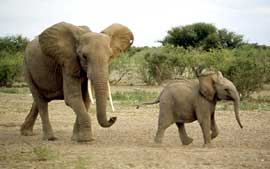
Elephant cow and calf A female usually bears her first calf between 10 and 20 years old and bears again every 4-6 years. It takes over a year and a half for an elephant embryo to develop, but at birth calves can stand within an hour, and swim soon after. Baby elephants drink milk from their mother's two breasts until 4-6 years later, when mom bears her next young. Despite a mother's tender care and the protection of the family, only a few calves live to adulthood. CommunicationElephants communicate a lot through touch, taste, and smell. A mother may bat her calf with her tail to make sure he is still following behind her, or she may turn and shove him as discipline. Two elephants who meet will "greet" with trunks outstretched, sniffing for clues about the other. (Incidentally, some scientists say that excited behavior during greetings may suggest that elephants remember one another, even after being separated for many years.)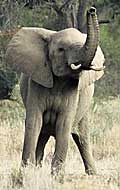
Trunk raised Elephants on alert will raise their trunks like periscopes, with the tips pointed toward whatever ill wind is blowing. They also can make more than 25 various vocalizations. Trumpets, screams, rumbles, and grunts all send a message, depending on how they are made. A series of long, low rumbles may be a signal for the family to get up and move on. A trumpet may be a show of intimidation; a special soft hum is a mother's song to her newborn. Some calls are made only by females, only by males, or by calves.
Infrasonic SoundsAmazingly, many elephant calls are too low (15 hertz) for human hearing ability (20 hertz). These infrasonic sounds are capable of traveling long distances, and most occur in the early morning or evening hours, when ground air is cool enough to carry the frequency without interference.At these times a single call can be heard for 110 square miles--perhaps advertising a female who is ready to mate. With such broadcast methods at their disposal elephants are always in touch with one another. Always moving on a whim. And sometimes a little fickle.
The forest elephant Loxodonta cycotis is found in African forests and is considered a separate species from the elephant found in the savannah, Loxodonta africana, but both are called African elephants. The Asian elephant is currently categorized in a separate genus and species: Genus Elephas ("Huge arc"); Species Elephas maximus ("Large") In addition the Asian is divided into four subspecies (although some claim they should be divided further): Elephas maximus maximus, found in Sri Lanka; Elephas maximus sumatranus, found in Sumatra and Borneo; Elephas maximus indicus, the mainland species found throughout South-east Asia; and lastly, the Borneo pygmy elephant, Elephas maximus borneensis which was discovered in 2003. Slight variations exist in each subspecies, but nothing too drastic. The
famed wooly mammoth, extinct though he is, is a relative of the African and
Asian and claims a genus of his own, Mammuthus.
This elephant biofile first appeared in Globelens.com, the burgeoning work of Daniel James Devine,
a writer and researcher with an unsettling amount of curiosity and a love for pictures and prose.
If you'd like to find out more about how elephants communicate, you should read this in-depth yet fascinating academic paper, Social Behaviour and Communication in Elephants. Return to Wildlife Articles |
|||||||||
|
| ||||||||||